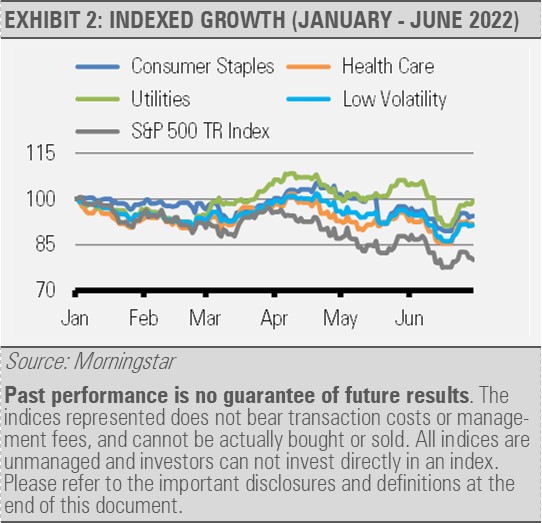One of the tenets to successfully invest in equity markets is to buy low and sell high. With the current environment full of geopolitical, economic, and market uncertainty, it can be even more difficult for investors to remain disciplined and stick to their financial plan. Picking an investment solution that can provide an opportunity for long-term gains while also helping sooth investors’ nerves may help investors stay the course.
As behavioral economics teaches us, market declines impact investors’ emotions at least twice as much as the euphoria of gains. This phenomenon, known as prospect theory, helped Daniel Kahneman win the 2002 Nobel Memorial Prize in Economic Sciences for his work developing the theory. Applying this theory to today’s stock markets, investors may be better able to sleep at night by owning more defensive equity positions.
Defensive equities are generally characterized as companies that deliver more consistent earnings than average regardless of economic environment. These companies are predominantly found in sectors, such as consumer staples, health care, and utilities, as well as equity factor investments that focus on the low volatility factor. What these businesses typically lack in terms of high growth rates, they tend to make up for in earnings stability. This earnings stability is often reflected in less volatile stock market price action and better downside protection than the broad equity market during difficult times.
For example, these more defensive investments have historically held up better than the broad equity market during market declines. While these types of investments typically lag the broad equity market when the market rallies, they do participate meaningfully to the upside.
Possibly most relevant to the current economic and market environment, these investments held up much better than the broad equity market during the first half of 2022 as the overall equity market experienced significant declines.
Stringer Asset Management has employed these strategies and others to help mitigate equity market volatility and smooth the ride for many years based on our focus on behavioral economics. Our goal is to help investors better navigate difficult markets, feel more confident in their investments, and sleep better at night.
DISCLOSURES
Any forecasts, figures, opinions or investment techniques and strategies explained are Stringer Asset Management, LLC’s as of the date of publication. They are considered to be accurate at the time of writing, but no warranty of accuracy is given and no liability in respect to error or omission is accepted. They are subject to change without reference or notification. The views contained herein are not be taken as an advice or a recommendation to buy or sell any investment and the material should not be relied upon as containing sufficient information to support an investment decision. It should be noted that the value of investments and the income from them may fluctuate in accordance with market conditions and taxation agreements and investors may not get back the full amount invested.
Past performance and yield may not be a reliable guide to future performance. Current performance may be higher or lower than the performance quoted.
The securities identified and described may not represent all of the securities purchased, sold or recommended for client accounts. The reader should not assume that an investment in the securities identified was or will be profitable.
Data is provided by various sources and prepared by Stringer Asset Management, LLC and has not been verified or audited by an independent accountant.
Index Definitions:
S&P 500 Consumer Staples TR Index – This Index is a capitalization-weighted index of the S&P 500 Index’s companies that are classified as members of the GICS consumer staples sector. The total return series includes the price change and reinvested dividends.
S&P 500 Health Care TR Index – This Index is a capitalization-weighted index of the S&P 500 Index’s companies that are classified as members of the GICS health care sector. The total return series includes the price change and reinvested dividends.
S&P 500 Utilities TR Index – This Index is a capitalization-weighted index of the S&P 500 Index’s companies that are classified as members of the GICS utilities sector. The total return series includes the price change and reinvested dividends.
S&P 500 Low Volatility TR Index – This Index is a capitalization-weighted index of the 100 least volatile stocks within the S&P 500 Index. The total return series includes the price change and reinvested dividends.
S&P 500 TR Index – This Index is a capitalization-weighted index of 500 stocks. The Index is designed to measure performance of a broad domestic economy through changes in the aggregate market value of 500 stocks representing all major industries. The total return series includes the price change and reinvested dividends.



